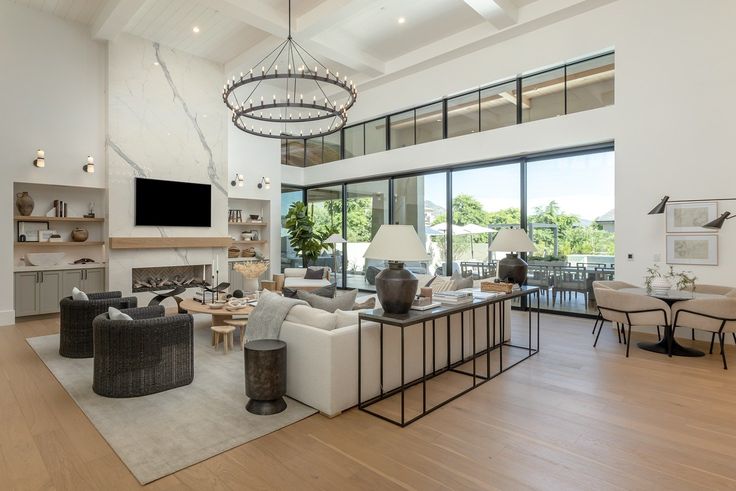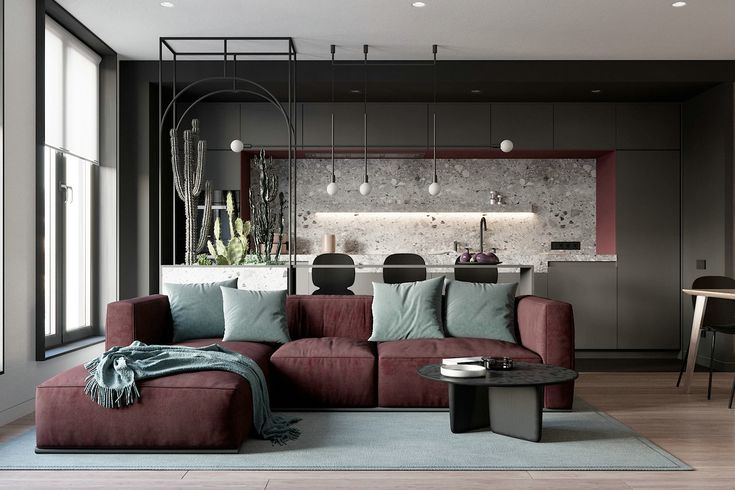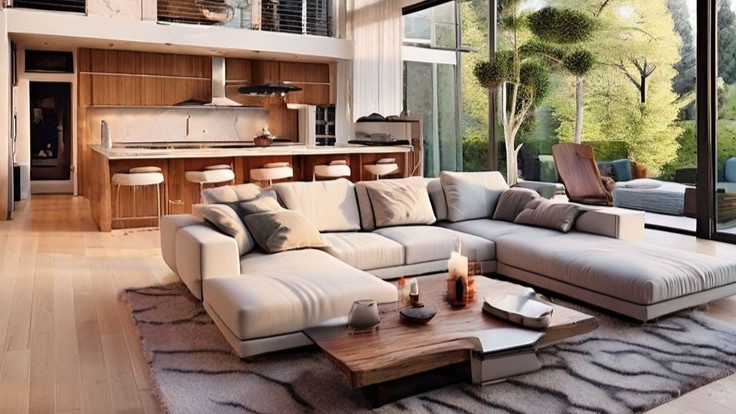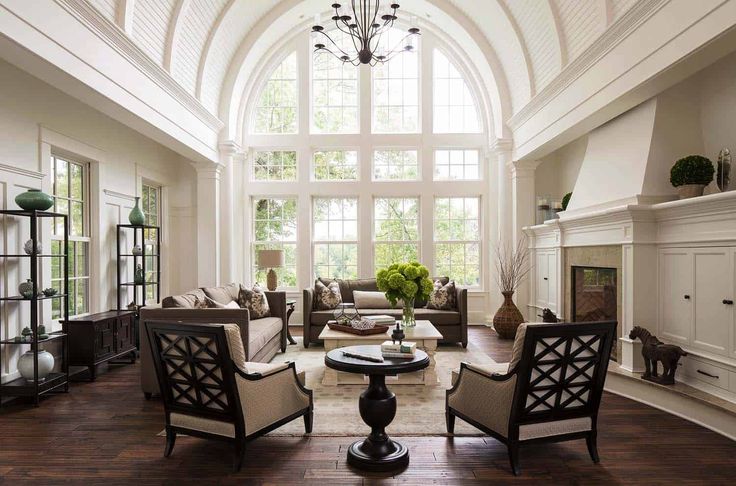Beyond Aesthetics: The Art and Function of Modern Home Interior Design
Beyond Aesthetics: The Art and Function of Modern Home Interior Design – Modern home interior design is more than just arranging furniture or selecting a color palette—it’s an evolving art form that harmonizes aesthetics with function. As trends shift and technology advances, the contemporary home becomes a canvas for innovative ideas, sustainable practices, and practical living. In this comprehensive guide, we explore the essence of modern home interior design, its evolution, key elements, and actionable tips to transform any space into a masterpiece of both art and functionality.
The Evolution of Modern Home Interior Design
The journey of modern home interior design reflects broader cultural and technological shifts. Early modernism in the mid-20th century was define by a move away from ornate details toward simplicity, functionality, and clean lines. Influenced by designers like Le Corbusier and Mies van der Rohe, the modern movement emphasized open spaces, minimalism, and the honest expression of materials.
Today, modern home interior design has evolved to incorporate sustainable practices, smart home technology, and a renewed focus on wellness. The balance between aesthetics and practicality is at the core of contemporary design, making every element count—whether it’s the placement of a sofa, the texture of a wall covering, or the integration of energy-efficient lighting.
Key Elements of Modern Home Interior Design
Modern home interior design is characterized by several essential elements that blend art with function. Understanding these components can help homeowners create a space that is both visually striking and highly functional.
Minimalism and Clean Lines
- Simplicity: Modern design embraces a “less is more” philosophy. Minimalism is about decluttering spaces to highlight quality over quantity. The focus is on essential furniture and decor that serve a purpose.
- Clean Lines: Straight, unembellished lines in furniture and architectural features create a sense of order. This approach not only makes spaces appear larger but also promotes a calming, organized environment.
Open Floor Plans
- Fluid Spaces: Open floor plans are a hallmark of modern interior design. They allow for flexible living arrangements and foster a sense of connectivity between different areas, such as the kitchen, dining, and living rooms.
- Natural Light: With fewer walls and partitions, open spaces allow natural light to flow freely, creating a bright, airy atmosphere that enhances the overall aesthetic.
Sustainable Materials
- Eco-Friendly Choices: Sustainability is a growing trend in modern design. Incorporating materials like reclaimed wood, recycled metal, and eco-friendly fabrics not only reduces environmental impact but also adds a unique texture and history to the design.
- Durability and Functionality: Modern materials are chosen for their longevity and ease of maintenance, ensuring that the design remains both beautiful and practical for years to come.
Integration of Technology
- Smart Home Features: Modern interiors seamlessly integrate technology. From smart thermostats and lighting systems to integrated audio-visual solutions, technology enhances comfort and efficiency.
- Innovative Solutions: Designers now use technology to solve everyday problems—think built-in charging stations, hidden storage compartments, and automated window treatments that contribute to a clutter-free and high-tech environment.
The Art Behind the Modern Look
While functionality is essential, modern home interior design is equally about making a statement. The artistic elements of design elevate everyday spaces into personalized sanctuaries.
Emphasizing Unique Furniture Pieces
- Statement Furniture: A single piece of well-designed furniture can serve as the focal point of a room. Designers often choose chairs, tables, or sofas that double as works of art.
- Ergonomic and Stylish: Modern furniture is not only about style but also about comfort. Ergonomic designs that support healthy living are integral to today’s interior trends.
The Role of Color and Texture
- Neutral Palettes: Many modern designs favor neutral color schemes such as whites, grays, and beiges, creating a timeless backdrop that allows individual pieces of art or furniture to shine.
- Accent Colors: Pop colors are used sparingly to create visual interest and highlight architectural features. These splashes of color can be introduced through artwork, decorative objects, or an accent wall.
- Variety of Textures: Mixing materials like glass, metal, wood, and fabric adds depth and richness to the design. The interplay of smooth surfaces with rough textures can evoke both warmth and modernity.
Art and Decor
- Curated Art Collections: Incorporating art into modern home interiors adds a personal touch. Whether it’s a large abstract painting or a series of minimalist prints, art pieces can transform a sterile space into a vibrant environment.
- Personal Touches: While modern design often emphasizes minimalism, it doesn’t preclude personalization. Curated decor items that tell a story—such as vintage artifacts or handmade crafts—add character and warmth.

Functionality Meets Style: Creating Practical Spaces
Modern home interior design is a delicate balance between artistic expression and everyday functionality. Every design decision should enhance the usability of a space without compromising its aesthetic appeal.
Multipurpose Spaces
- Flexibility: With urban living on the rise, spaces must serve multiple functions. A living room might double as a home office, or a guest room might transform into a workout area. Multipurpose designs ensure that every square foot is optimized.
- Adaptive Furniture: Convertible furniture, such as sofa beds and extendable dining tables, exemplifies modern design’s commitment to versatility. These pieces allow homeowners to adapt their spaces as needed.
Efficient Storage Solutions
- Hidden Storage: Clutter can disrupt the clean, minimalist look of modern interiors. Integrated storage solutions, such as built-in cabinets and under-stair storage, help maintain an organized space.
- Modular Systems: Modular shelving and storage systems are flexible and can be customized to fit different needs, making them ideal for modern homes that require both style and function.
Embracing Open-Concept Layouts
- Seamless Transitions: Open-concept layouts are designed to facilitate movement and interaction. They encourage a flow between spaces, which is particularly beneficial for families and those who entertain frequently.
- Zoning with Design Elements: Even in open layouts, designers can create distinct zones using area rugs, lighting, and furniture placement. This approach ensures that every part of the space has a clear purpose without compromising the overall aesthetic.
Incorporating Technology and Innovation
In today’s connected world, technology plays an indispensable role in modern home interior design. The integration of tech not only enhances convenience but also contributes to energy efficiency and security.
Smart Home Integration
- Automated Systems: Smart home technology allows for the automation of lighting, heating, and security systems. Homeowners can control these features remotely, ensuring comfort and efficiency even when they’re away.
- Voice-Controlled Devices: Devices like smart speakers and voice assistants integrate seamlessly into modern interiors. They offer hands-free control of various home functions, adding both convenience and a touch of futuristic style.
Innovative Design Tools
- Virtual Reality (VR) and Augmented Reality (AR): These technologies are transforming how interior design is approached. Homeowners can now visualize how different design elements will look in their space before making a commitment.
- 3D Printing and Customization: Custom furniture and decor elements can now be produced using 3D printing technology. This innovation enables highly personalized designs that perfectly fit the space and style preferences of the homeowner.
Energy Efficiency and Sustainability
- Smart Lighting: LED lighting systems that adjust based on natural light levels contribute to energy savings while enhancing the ambiance of a room.
- Green Technologies: Modern homes increasingly incorporate renewable energy sources such as solar panels and energy-efficient appliances, reflecting a commitment to sustainability and modern innovation.
Designing for Sustainability and Wellness
Modern home interior design is not just about looks—it’s also about creating a healthy, sustainable living environment. This focus on wellness and sustainability is transforming the way we think about home interiors.
Eco-Friendly Materials and Practices
- Sustainable Sourcing: The use of eco-friendly and ethically sourced materials is a cornerstone of modern design. Reclaimed wood, recycled metals, and non-toxic finishes are popular choices that reduce the environmental impact.
- Energy-Efficient Design: Incorporating energy-efficient appliances, windows, and insulation helps create a home that is not only beautiful but also economical and environmentally responsible.
Enhancing Indoor Air Quality
- Natural Ventilation: Modern design often emphasizes open layouts that allow for better airflow and natural ventilation, reducing the need for air conditioning and improving indoor air quality.
- Indoor Plants: Greenery is a natural way to boost wellness. Indoor plants not only purify the air but also add a touch of nature, softening the stark lines of modern design.
Creating Spaces for Well-Being
- Mindful Spaces: Design elements that promote relaxation and mindfulness—such as meditation corners, spa-like bathrooms, or quiet reading nooks—are increasingly popular in modern interiors.
- Ergonomic Considerations: From adjustable standing desks to ergonomic seating, modern home design incorporates features that support physical well-being, reducing the risk of strain and injury.

Tips for Achieving Modern Home Interior Design
Whether you’re renovating your current home or starting from scratch, these tips can help you achieve a balance between art and function in your modern home interior design.
Start with a Vision
- Define Your Style: Spend some time researching and defining what modern means to you. Create a mood board or a digital folder with images, color schemes, and design elements that resonate with your vision.
- Set Priorities: Determine which aspects of design are most important—be it sustainability, technology integration, or multipurpose functionality. This will guide your decisions throughout the design process.
Choose a Neutral Base
- Color Palette: A neutral color base provides a versatile foundation for any design. Whites, grays, and beiges create a calm backdrop that can be easily accented with bold colors or unique art pieces.
- Consistency: Keeping the base consistent throughout the home helps create a sense of unity, making it easier to introduce eclectic or personalized elements later.
Invest in Quality Over Quantity
- Statement Pieces: Invest in high-quality, functional furniture that can stand the test of time. A well-chosen statement piece can elevate your space without overcrowding it.
- Timeless Design: Aim for timeless designs that won’t look dated as trends evolve. Quality craftsmanship and enduring materials are key to creating a lasting impression.
Embrace Flexibility
- Modular Designs: Opt for modular furniture and flexible layouts that can adapt to your changing needs. This flexibility is particularly important in modern homes, where space optimization is crucial.
- Future-Proofing: Consider the integration of technology and sustainable features that can be easily upgraded. Future-proofing your home means you won’t be stuck with outdated systems as innovations emerge.
Balance Art and Function
- Personal Touch: Don’t be afraid to showcase your personality through curated art collections, unique decor items, or even a splash of unexpected color.
- Practical Choices: Every decorative element should also serve a purpose. Look for items that blend aesthetics with utility—such as stylish storage solutions or multi-use furniture.
Incorporate Natural Elements
- Biophilic Design: Integrate natural elements into your design to create a calming, organic environment. Use indoor plants, natural textures, and materials to soften the modern edge.
- Lighting: Maximize natural light wherever possible. Large windows, skylights, and strategically placed mirrors can enhance the brightness and warmth of a space.
Future Trends in Modern Home Interior Design
As we look ahead, several trends are poised to shape the future of modern home interior design. Understanding these trends can help homeowners and designers stay ahead of the curve.
Increased Customization and Personalization
- Bespoke Designs: With advancements in technology like 3D printing and virtual reality, bespoke furniture and decor tailored to individual preferences are becoming more accessible.
- Personalized Spaces: Future interiors will likely place even greater emphasis on personalized spaces that reflect the unique lifestyles and tastes of the inhabitants.
Integration of Advanced Technologies
- Seamless Connectivity: The next wave of smart home technology will focus on seamless connectivity between devices, creating truly integrated living environments.
- AI in Design: Artificial intelligence may soon play a role in designing personalized interior layouts based on data-driven insights into living habits and preferences.
Greater Focus on Health and Wellness
- Holistic Living Spaces: Future designs will further emphasize wellness, incorporating elements that promote mental and physical health—from circadian lighting systems to dedicated wellness rooms.
- Sustainable Living: As environmental awareness grows, sustainable and energy-efficient designs will become the norm, rather than the exception.
Conclusion
Modern home interior design is a dynamic field that goes far beyond superficial aesthetics. It’s an art form that combines minimalism, innovative technology, and sustainable practices to create living spaces that are as functional as they are beautiful. By embracing the principles of open layouts, eco-friendly materials, and smart technology, homeowners can craft environments that not only reflect their personal style but also enhance their quality of life.
Whether you’re drawn to the sleek lines of minimalism or the warmth of natural textures, the essence of modern interior design lies in its ability to adapt and evolve. As we continue to redefine what it means to live well, the fusion of art and function will remain at the heart of our homes—transforming everyday spaces into extraordinary sanctuaries that are truly beyond aesthetics.
By keeping an eye on emerging trends and integrating timeless design principles, you can create a home that not only meets your current needs but is also poised to adapt to the future. Embrace the art and function of modern home interior design, and let your living space tell the story of who you are—innovative, thoughtful, and ever-evolving.
Modern home interior design is a journey—a continuous evolution of form, function, and technology. It is a reflection of our desire to live better, work smarter, and enjoy spaces that nurture both creativity and well-being. As you embark on your design journey, remember that every choice you make contributes to a larger narrative—one where art meets function, and every element has a purpose. Let your home be a testament to the beauty of modern design, where every corner exudes elegance, innovation, and a commitment to sustainable living.
Embrace the future, celebrate the present, and create a space that is uniquely yours. After all, in the realm of modern interior design, it’s not just about how your home looks—it’s about how it makes you feel every day.






